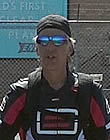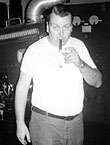|
|
This topic comprises 2 pages: 1 2
|
|
Author
|
Topic: specifying booth electrical service
|
Scott Norwood
Film God

Posts: 8146
From: Boston, MA. USA (1774.21 miles northeast of Dallas)
Registered: Jun 99
|
 posted 06-16-2010 12:05 PM
posted 06-16-2010 12:05 PM





This is for a community theatre that is in the process of renovating to become a multi-use facility that will open next summer. I am tangentially involved with this and have been advising them on all things film (though the primary purpose of the venue will be live stage and music performances).
Their booth is being re-wired, and the electrician needs to know what type of service to provide for the film projectors and related equipment. The booth will also include amps for the house system (also used for live performances), other sound equipment, and some sort of lighting equipment, all of whose requirements will be specified by others. The booth will have three-phase power.
Lamphouses will be 2.5kw, probably Super Lume-X with Strong rectifiers (probably switchers, but not sure yet), but they have not been purchased yet, and exact models are unknown. Projectors will be Centurys on Simplex soundheads (this is what is already there).
This is a bit out of my league, but here is what I have come up with so far. Any comments or clarifications would be appreciated.
Circuit list should include the following:
- ceiling/work lights (120v/20a)
- wall outlets (120v/20a)
- roof exhaust (?v/?a)
- projector #1 motor (120v/20a)
- projector #2 motor (120v/20a)
- electric c/o (120v/20a)
- threading lamps/LED power supplies (120v/20a)
- cinema processor and booth monitor (120v/20a)
- rewind bench outlet (120v/20a)
- video projector (?v/?a)
- video monitors (120v/20a)
- other video (DVD player, switcher/scaler) (120v/20a)
- hearing-impared system?
Questions:
- is there any reason not to specify a separate electrical panel for the film equipment? (I am concerned that the booth will be used for other purposes, and that non-projectionists will touch things that they should not.)
- how much power should be specified for rectifiers, and how much heat do they produce (worst case; rectifiers will be in the booth, as there is no separate rectifier room)?
- is there any reason not to use a common ground for all projection and sound equipment?
- how should the load be distributed amongst the 3 phasess? should all sound equipment be kept on its own phase?
- does anyone run separate circuits for sound c/o relays and/or motor-start relays?
- does anyone prefer to mount LED power supplies in the rack instead of on the sides of the projector bases?
- should I be scared of having lighting equipment (dimmers?) near sound equipment?
- is there anything else that the electrician should know to do or not do?
I realize that this comes dangerously close to asking for free consulting, but the budget is minimal (I am not being paid for my time, either), and I would prefer that they avoid making expensive mistakes. My only reason for involvement in this is the hope that they will put on an interesting film program on nights when there are no stage performances.
Any ideas/advice/suggestions would be appreciated.
| IP: Logged
|
|
|
|
|
|
|
|
|
|
|
|
|
|
|
|
|
|
|
|
Tony Bandiera Jr
Film God

Posts: 3067
From: Moreland Idaho
Registered: Apr 2004
|
 posted 06-17-2010 01:01 PM
posted 06-17-2010 01:01 PM




- is there any reason not to specify a separate electrical panel for the film equipment? (I am concerned that the booth will be used for other purposes, and that non-projectionists will touch things that they should not.)
No. A separate panel is a very good idea. As mentioned by Gordon S. put all cinema and video in the same panel.
- how much power should be specified for rectifiers, and how much heat do they produce (worst case; rectifiers will be in the booth, as there is no separate rectifier room)?
A 30amp, 3-phase circuit will work for switchers, magnetic should be the same depending on brand. Mag rectifiers will produce a lot more heat, but you can put them in the booth without too much worry. The natural extraction of air for the lamphouses will help to draw some of the rectifier heat out. MAKE SURE YOU HAVE AT LEAST 600-800 CFM AT EACH LAMPHOUSE STACK FOR EXHAUST!!
- is there any reason not to use a common ground for all projection and sound equipment?
No and as mentioned, heavier grounds are better and important.
- how should the load be distributed amongst the 3 phasess? should all sound equipment be kept on its own phase?
Load should be distributed as equally as possible on all three phases, and no, DO NOT group all the sound equipment on one phase. It is NOT necessary if good wiring practices for the audio leads are followed.
**IMPORTANT: MAKE SURE ALL AND I MEAN ALL AUDIO CIRCUITS ARE FED WITH DEDICATED NEUTRALS FOR EACH CIRCUIT!! ABSOLUTELY NO "SHARED NEUTRALS" IN ANY OF THE AUDIO OR VIDEO CIRCUITS.**
You should have at least 5 circuits for your video/audio system, one circuit for processor, booth monitor, server, one for all the video gear and at least three circuits for the amplifiers.
- does anyone run separate circuits for sound c/o relays and/or motor-start relays?
Not required, but a good idea so you can cut off power to the c/o's, worklites and aux devices.
- does anyone prefer to mount LED power supplies in the rack instead of on the sides of the projector bases?
I have no preference. If rack space is available to mount them on a panel so the power LED's are visible, I do rack mount. Otherwise they go in the bases and are powered by the c/o breaker.
- should I be scared of having lighting equipment (dimmers?) near sound equipment?
YES!! Be afraid, be very afraid. ![[Smile]](smile.gif) Try to keep as much distance physically and electrically between audio/video equipment and dimmer powers. Try to keep as much distance physically and electrically between audio/video equipment and dimmer powers.
- is there anything else that the electrician should know to do or not do?
Yes. As mentioned, NO SHARED NEUTRALS allowed on ANY of the audio/video branch circuits. Make sure each circuit has a ground wire installed (DO NOT rely on conduits for grounding in this case.) And make sure they install the circuits YOU need and specify in the locations you tell them to do so.
There is another thread on here where I go into detail on circuit requirements.
| IP: Logged
|
|
|
|
Tony Bandiera Jr
Film God

Posts: 3067
From: Moreland Idaho
Registered: Apr 2004
|
 posted 06-17-2010 01:52 PM
posted 06-17-2010 01:52 PM




Scott, for worklights I have track lights mounted on the front wall by each projector and they are on dimmer switches, no worries for noise there.
I have found rack "littlelites" to be almost useless. You would be better served with a light on a dimmer mounted on the wall nearby and aimed at the rack. The reel light you mentioned would be a great idea for working on the backside of the rack..and if placed correctly it could be used to work on the projectors.
Yes the HVAC guy deals with the lamp blowers. He'd better know what to do if you provide the specs, if not he should lose his license. Make sure you show him the exact locations of the drops into the lamphouses too.
STAND FIRM on 600 CFM minimum for EACH of the lamps!! I don't care what local codes say, 300cfm is NOT anywhere near enough for anything but a 1k lamp running at 800 watts. YOU are the one who's gonna have to deal with short lamp life, damaged reflectors and burned fingers in the trap if the cooling isn't up to par. And changing it after the fact is super expensive!!
OH, very important: The lamp exhaust blowers need to be controlled exclusively by the projectionist with a switch in the booth, and ABSOLUTELY IN NO WAY controlled by the building's A/C system or energy management system!! UC Irvine has found that out the hard way to the tune of over $3,000 to replace a damaged reflector in my Kinotons.
Steve or Mark can answer the D-Crapema question, but I think it is closer to 800 cfm and I would insist on a separate exhaust blower for it. Again, if you think it could happen, install it NOW rather than later. Lots less money (and mess) too.
| IP: Logged
|
|
|
|
|
|
|
|
All times are Central (GMT -6:00)
|
This topic comprises 2 pages: 1 2
|
Powered by Infopop Corporation
UBB.classicTM
6.3.1.2
The Film-Tech Forums are designed for various members related to the cinema industry to express their opinions, viewpoints and testimonials on various products, services and events based upon speculation, personal knowledge and factual information through use, therefore all views represented here allow no liability upon the publishers of this web site and the owners of said views assume no liability for any ill will resulting from these postings. The posts made here are for educational as well as entertainment purposes and as such anyone viewing this portion of the website must accept these views as statements of the author of that opinion
and agrees to release the authors from any and all liability.
|

 Home
Home
 Products
Products
 Store
Store
 Forum
Forum
 Warehouse
Warehouse
 Contact Us
Contact Us




 Printer-friendly view of this topic
Printer-friendly view of this topic











![[Smile]](smile.gif)

![[Wink]](wink.gif)



